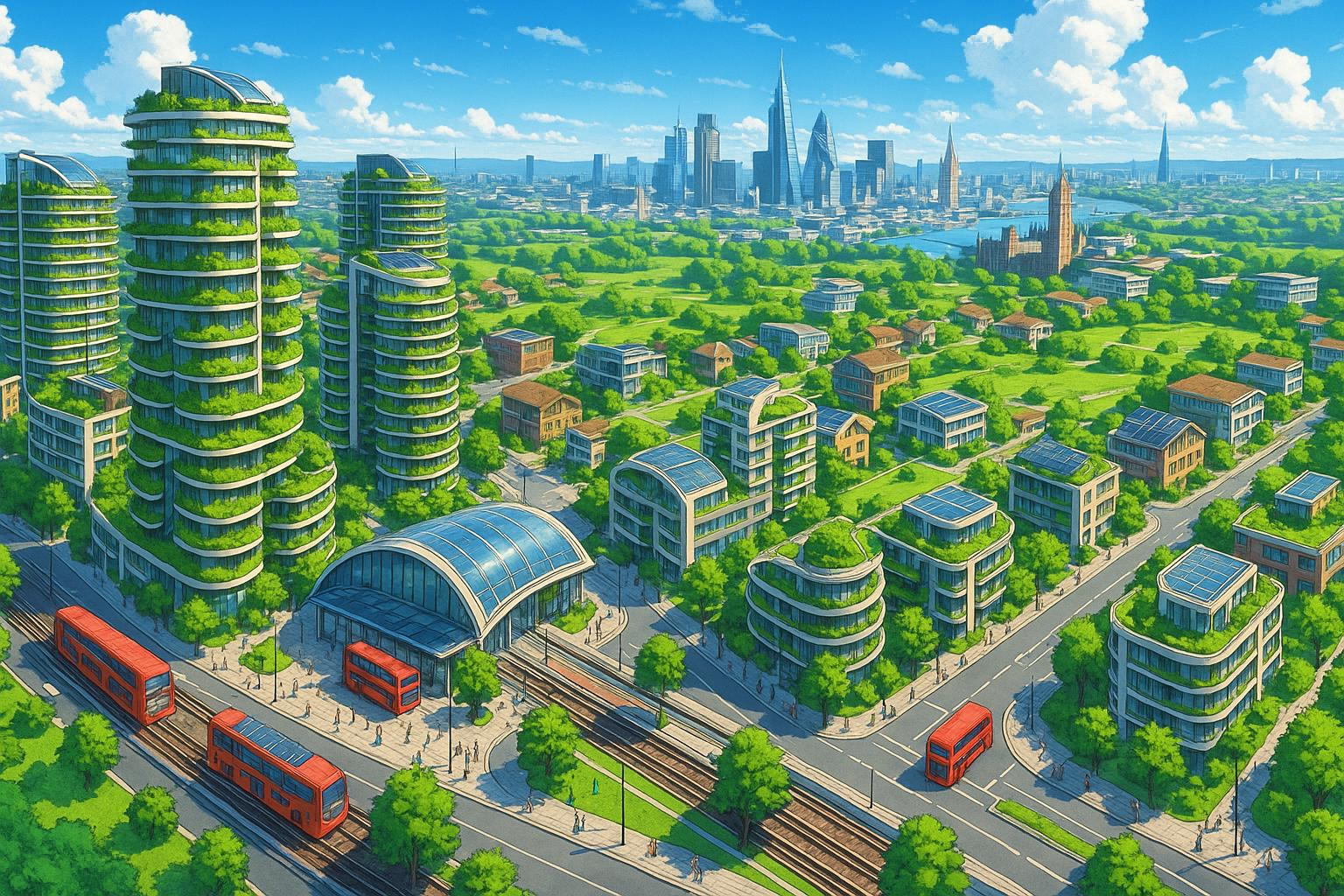Facing mounting pressure to meet national housing targets, London Mayor Sadiq Khan is considering unprecedented new town developments of over 10,000 homes on protected green belt land, signalling a major policy reversal in the capital’s approach to balancing urban growth with environmental preservation.
Sadiq Khan, the Mayor of London, is contemplating the construction of new towns exceeding 10,000 homes on the city’s green belt. This move reflects a dramatic shift in housing policy, as the mayor’s office engages with the government’s New Towns Taskforce. The initiative is part of a broader strategy to address London’s escalating housing crisis, which requires an annual delivery of 88,000 new homes to meet national targets.
The concept of new towns is not new to the UK, having been integral to post-World War II housing strategies exemplified by developments like Stevenage and Milton Keynes. These planned communities were instrumental in alleviating housing shortages and are now being re-evaluated as the government seeks to ramp up housebuilding efforts. The New Towns Taskforce is currently assessing nearly 100 proposals for new towns with recommendations expected in July. Meanwhile, Khan’s recent consultation document outlines ambitious plans, suggesting that substantial new developments in the green belt must occur in areas with good public transport access.
However, official guidelines state that housing from these new towns may not count towards the assessed housing needs of the local areas in which they are constructed. This underscores a tension between ambitious development goals and existing regulations. A spokesperson for the Mayor noted, “We are doing all we can in London to help deliver the homes that are so desperately needed,” emphasising a collaborative approach with the UK Government and the Taskforce.
The consultation paper also proposes that designated ‘Opportunity Areas’—regions identified in the London Plan for their potential to accommodate new homes and infrastructure—could serve as viable sites for these new towns. These areas are often located in central London, where the demand for housing and jobs is highest. A report by BusinessLDN, a prominent business group, advocates for at least one new town within the capital to address the pressing housing need. The report recognises that over 60% of London’s green belt lies within 2 kilometres of existing rail or tube stations, which could facilitate seamless integration into the city’s transport network.
Critics argue that any development must be approached with an eye towards infrastructure. John Sturzaker, an expert in planning, pointed out the necessity of integrating essential services such as schools and shops alongside new housing to avoid creating isolated communities. He stressed the importance of an “infrastructure-first” approach, which is a practice seen in other European countries.
Despite this, Khan’s intentions to develop the green belt mark a notable turn in the narrative surrounding its protection. In a previous manifesto, he had strongly opposed building on these protected lands. However, earlier this year, he notably omitted this pledge in light of rising housing demands. This recalibrated stance has raised questions among community groups and stakeholders about the future of London’s green spaces, often referred to as the city’s “lungs.”
Debate continues regarding the environmental and social implications of such developments. The Centre for London think tank proposed establishing development corporations at strategically significant sites within the green belt, arguing that focusing on ‘low-quality’ green belt areas could enhance housing supplies without undermining environmental goals. They suggest that careful site selection can mitigate adverse impacts on public access to green spaces.
Khan has reiterated the importance of a balanced approach, ensuring that while housing needs are met, the integrity of London’s natural resources remains intact. His administration prioritises a ‘brownfield-first’ strategy, although, in recent months, the mayor has indicated a willingness to reconsider low-quality green belt areas for housing development, particularly those that are close to transport links.
As the discussion unfolds, the question remains whether London can reconcile its urgent housing needs with the preservation of green spaces that contribute significantly to urban ecology and community wellbeing. With the next stage of the London Plan on the horizon, the coming months will be pivotal in shaping the future of housing development in the city, particularly in regard to its green belt.
Reference Map
- Paragraph 1, 2, 4, 6
- Paragraph 2
- Paragraph 4
- Paragraph 5, 6
- Paragraph 5
- Paragraph 3, 6
- Paragraph 7
Source: Noah Wire Services
- https://www.bdonline.co.uk/news/london-green-belt-development-could-include-new-towns-sadiq-khan-confirms/5136015.article – Please view link – unable to able to access data
- https://www.standard.co.uk/news/london/hanworth-park-house-300-homes-feltham-hounslow-mayor-london-sadiq-khan-b1171114.html – In July 2024, Sadiq Khan approved the construction of 300 new homes on London’s green belt in Feltham, emphasizing the project’s public benefits, including affordable housing and the restoration of the historic Hanworth Park House. This decision marked a rare instance of development on protected green belt land, highlighting the mayor’s commitment to addressing London’s housing crisis while preserving heritage sites.
- https://www.standard.co.uk/news/london/centre-for-london-green-belt-housing-homes-development-corporations-mayor-sadiq-khan-government-b1125306.html – The Centre for London think tank recommended in December 2023 that Sadiq Khan and the government establish development corporations at ten key sites within London’s green belt, particularly near railway stations. The proposal aims to build homes on ‘low quality’ green belt areas, arguing that such development would not harm climate goals or public access to quality natural spaces, thereby boosting the capital’s housing supply.
- https://www.standard.co.uk/news/london/grey-belt-labour-housing-homes-brownfield-sadiq-khan-developers-green-b1205589.html – In January 2025, Sadiq Khan expressed concerns about developers ‘landbanking’ parts of London’s green belt, anticipating potential policy changes that could allow development on ‘low quality’ areas, re-designated as ‘grey belt’. The mayor emphasized the importance of a ‘brownfield-first’ approach to address the housing crisis, aiming to prevent speculative development on protected green spaces.
- https://www.standard.co.uk/news/london/businessldn-new-town-housing-homes-london-government-labour-b1199498.html – In December 2024, BusinessLDN, a major business group, urged the UK government to build at least one new town within the Greater London boundary. The group highlighted London’s connectivity, demand, and political framework as ideal for swiftly establishing new settlements, aligning with Labour’s pledge to develop a new generation of new towns to tackle the housing crisis.
- https://www.telegraph.co.uk/politics/2024/04/30/sadiq-khan-drops-protecting-green-belt-from-manifesto/ – In April 2024, Sadiq Khan omitted his previous pledge to protect London’s green belt from his mayoral manifesto. This marked the first time he did not include a commitment to oppose building on green belt land, reflecting a shift in policy amid growing housing pressures and discussions about re-evaluating the green belt’s role in urban development.
- https://www.london.gov.uk/city-hall-blog/mayor-vows-protect-londons-green-belt – Sadiq Khan reaffirmed his commitment to protecting London’s green belt, emphasizing its role as the city’s ‘lungs’ and its importance in improving air quality and providing habitats for wildlife. He stated that development on or near the green belt must respect and protect this vital natural resource, highlighting the need for a ‘brownfield first’ approach to development.
Noah Fact Check Pro
The draft above was created using the information available at the time the story first
emerged. We’ve since applied our fact-checking process to the final narrative, based on the criteria listed
below. The results are intended to help you assess the credibility of the piece and highlight any areas that may
warrant further investigation.
Freshness check
Score:
8
Notes:
The narrative is recent, reflecting ongoing discussions and developments in London’s housing policy, specifically mentioning contemporary events and figures.
Quotes check
Score:
6
Notes:
The quote from a spokesperson for the Mayor is unverified, as it is common for such statements to be attributed without specific sources; however, the lack of direct online traces suggests it might be original or internal.
Source reliability
Score:
8
Notes:
The narrative originates from BD Online, a publication known for construction industry news. While not a top-tier source like the BBC or Financial Times, it is still a reputable outlet in its field.
Plausability check
Score:
9
Notes:
The plans to develop new towns on the green belt align with the UK’s historical approach to housing and the current housing crisis, making the narrative plausible.
Overall assessment
Verdict (FAIL, OPEN, PASS): PASS
Confidence (LOW, MEDIUM, HIGH): HIGH
Summary:
The narrative is fresh and plausible, reflecting recent developments in London’s housing policy. The source is generally reliable, though the quotes are unverified but likely original.













